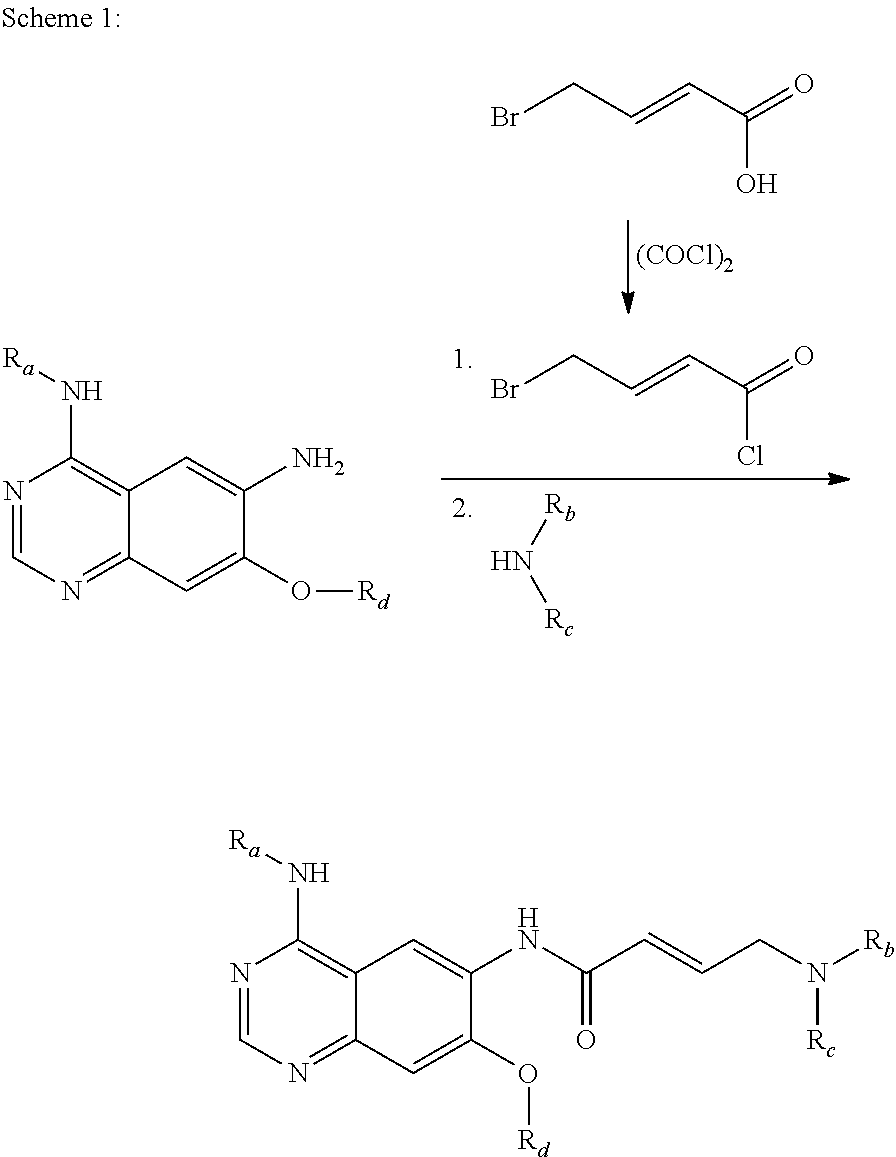Process for the manufacture of (e)-4-n,n-dialkylamino crotonic acid in HX salt form and use thereof for synthesis of EGFR tyrosine kinase inhibitors
a technology of dimethyl crotonic acid and hx salt, which is applied in the preparation of aminocarboxyl compounds, organic chemistry, and compound preparations. it can solve the problems of poor application prospects, severe drawbacks, and inability to commercialize bromocrotonic acid in large quantities, so as to improve the operation safety of production scale
- Summary
- Abstract
- Description
- Claims
- Application Information
AI Technical Summary
Benefits of technology
Problems solved by technology
Method used
Image
Examples
example 1
Preparation of Compound 1 (R1═R2=Me)
Sodium 2-Dimethylamino-1-hydroxy-ethanesulfonate
[0038]To a 5 L jacket reactor, (Dimethylamino)acetaldehyde diethyl acetal (400 g) and Water (200 mL) is charged at room temperature. Start agitation and cool the system down to 0° C., then Conc. HCl aqueous solution (37 wt %, 480 g) is added within 1 h, followed by stirring at 40° C. for 4 h. At this point, a solution of sodium metasulphite (424 g) in water (720 mL) is added into the above system within 40 min, and keep stirring at 40° C. for 2 h. The ethanol (2 L) is added and cool the mixture to 0° C., followed by filteration and washing with ethanol to get a white cake, which is dried in vacuo at 45° C. for 6 h to give desired compound 1 in 84% yield (474 g) and >98% NMR purity.
example 2
Preparation of Compound 2 (R3=Et)
(Diethoxy-phosphoryl)-acetic acid tert-butyl ester
[0039]Triethyl phosphite (485 g) is warmed up to 90° C. under N2 atmosphere in a three-necked round-bottomed flask, and t-butyl bromoacetate (541 g) is added dropwise into the system within 2 h. Then the mixture is kept stirring at 90° C. for around 4 h, and then cooled to room temperature. The obtained mixture is distilled under vacuo to remove compounds with low boiling point, and the residue is collected as a colorless liquid compound 5 in 97% yield (680 g) and >98% GC purity.
example 3
Preparation of Compound 3 (R1═R2=Me)
(E)-4-Dimethylamino-but-2-enoic acid tert-butyl ester
[0040]Charge tert-Butyl diethyl phosphonoacetate (3, 252 g), sulphite adduct (2, 240 g) and water (720 mL) to a 5 L jacket reactor, and cool the mixture down to 0° C. A solution of NaOH aqueous solution (2.5 mol / L, 1.5 L) is added dropwise into the system within 1 h, and keep stirring at this temperature until process monitoring indicates less than 5 area % compound 3 remains. The mixture is extracted with MTBE (1 L x 3), followed by distillation under vacuo to give compound 3 as a pale-yellow liquid in 100% yield (185 g) and 92% GC purity, which is used directly for the next step without further purification.
PUM
 Login to View More
Login to View More Abstract
Description
Claims
Application Information
 Login to View More
Login to View More - R&D
- Intellectual Property
- Life Sciences
- Materials
- Tech Scout
- Unparalleled Data Quality
- Higher Quality Content
- 60% Fewer Hallucinations
Browse by: Latest US Patents, China's latest patents, Technical Efficacy Thesaurus, Application Domain, Technology Topic, Popular Technical Reports.
© 2025 PatSnap. All rights reserved.Legal|Privacy policy|Modern Slavery Act Transparency Statement|Sitemap|About US| Contact US: help@patsnap.com



